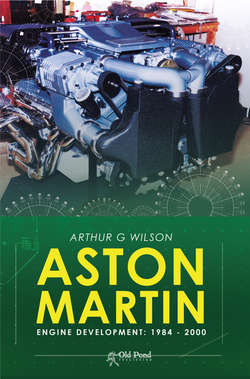Читать книгу Aston Martin Engine Development: 1984-2000 - Arthur Wilson L. - Страница 9
На сайте Литреса книга снята с продажи.
London Brick Co to Aston Martin Lagonda
ОглавлениеI was about seven years of age when I first fell in love with a motor car. Up to that time and bearing in mind that I was born in the same year as the Spitfire made its first flight, it had been aircraft that had been my main interest. The subject of my new affection was our first family car, a 1934 Wolseley Hornet Special known as Phoebe II. As was the practice of the time, the name had been professionally sign-written on the offside front of the long bonnet and was there when my parents bought the car. To a young lad, Phoebe was everything that a real sports car should be. The engine was a lovely little six-cylinder with single overhead cam, twin Skinners Union (SU) carburettors and loads of chrome oil pipes. It made a wonderful noise and smelled of hot oil mixed with a sort of hot electrical insulation material, all scary stuff. It still gives me a tingle when I think about it, funny how smell is such an important part of one’s memories of old cars. From then on I was hooked, particularly on 1930s sports cars.
When I left school at the age of 15, I began a six-year apprenticeship as a motor fitter at the London Brick Company (LBC) at Newton Longville, note the old term ‘fitter’ rather than ‘mechanic’. I would be working on the fleet of lorries used to transport the company product, not the sports or racing cars that I would have liked. But I was told that the standard of fitting required on diesel engines of the time was much higher than for the run-of-the-mill petrol engine and would stand me in good stead for later. Also the LBC provided one of the best apprentice schemes local to me at that time.
The lorries were mostly diesel engine AEC with a couple of ERF that I remember did not have starter motors. They were started on the handle that in the depths of winter sometimes required a team of men on a long rope and a guy in the cab with a flare down the intake to get them started. The flare was a piece of welding wire twisted around a piece of rag at the end, which was dunked into the fuel tank, set alight and held over the air intake while the engine was cranked. The flare procedure was common practice for all of the diesel engines in cold weather. There was also a number of side valve petrol engine Morris Commercials for more local deliveries and a small fleet of vans, buses, coaches and an ambulance to maintain.
We occasionally had manager’s company cars in for work. These were mostly Morrises or Wolseleys, which I remember as increasing in Royal Automobile Club-rated horsepower in line with the status of the manager. The chairman of the company had a beautiful dark green Aston Martin DB2/4, which sometimes came in for a wash and polish. Unfortunately that was all – we didn’t get to work on the car; I expect that it went back to Feltham for any service work. But it was a rather special treat for those of us who were motor enthusiasts just to be able to admire such a beautiful car at close quarters. He also had an ash green Jaguar XK120 that came in for the same treatment. I must admit that I slightly favoured the looks of the XK120; it was just so stunningly beautiful with a great looking engine. But I also recognised that underneath that beautiful body, the mechanical bits were less impressive – the workmanship on the Aston was far superior. The engineering on the Aston had a beauty of its own and it was really just as good looking but in a more refined way.
I completed my apprenticeship in June 1957, having specialised on engines. At the beginning of 1959 I was surprised to see an advert for engine builders at the Aston Martin factory at Newport Pagnell. I knew that Aston Martin had a factory at Feltham and hadn’t realised that the company had set up just a few miles away from Bletchley where I lived. With the image of that beautiful DB2/4 in mind I just had to apply. So after making an appointment by phone and armed with every qualification, certificate, commendation and prize certificate that I could lay my hands on I drove to Newport Pagnell in my pride and joy, an Austin Healey 100.
It would be an understatement to say that I was very nervous during the interview; even the slightest possibility of working for such a prestigious motor manufacturer gave me goose pimples. I just had to get the job. Happily I did and started soon after as third man in what was then the DB4 engine pre-production build area in the Olympia building, so called because of the shape of the roof. This was before the end was cut off at an angle for road widening, which if I remember correctly happened during the winter of 1960. I remember that the pay was slightly less than I was getting at the LBC and I would have to drive to work each day. But I didn’t mind too much, after all I was going to be working for Aston Martin.
I have one regret about that time and that is that in the excitement I didn’t have the grace to properly thank the LBC guys that I had been working with and in particular the manager Chris Johnson for all of their help and patience during my apprenticeship. Self-centred youth, I suppose.
